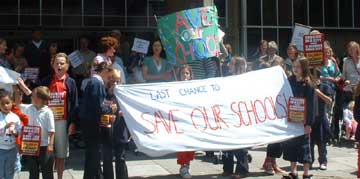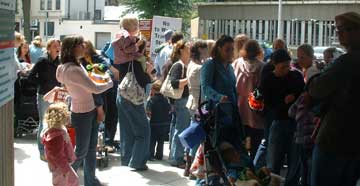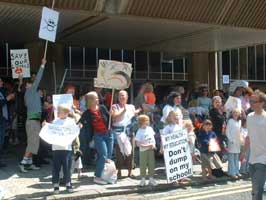Veolia 2006-planning committee
The planning committee meeting
Monday 19th June: at a special meeting, Les Hamilton the Chair of the Planning Applications Sub-Committee counted 8 votes FOR and 4 votes AGAINST Veolia's proposals.
So now Veolia has the Council's go-ahead to build a Waste Transfer Station and Materials Recovery Facility at Hollingdean Depot subject to several planning obligations and 53 conditions.  Council Officers' Report and Recommendation - the Council's go-ahead for Veolia's Hollingdean Depot is subject to the planning obligations and conditions listed in this document. If the developer breaches any of these conditions, then planning permission may be withdrawn. Local residents wishing to minimize the adverse effects of this development, should know what the obligations and conditions are.
Council Officers' Report and Recommendation - the Council's go-ahead for Veolia's Hollingdean Depot is subject to the planning obligations and conditions listed in this document. If the developer breaches any of these conditions, then planning permission may be withdrawn. Local residents wishing to minimize the adverse effects of this development, should know what the obligations and conditions are. 
The Waste Hierarchy - presented by Alan Buck
The background to the development (the Council is both client and adjudicator) was presented by the Council's Projects Officer, Alan Buck.
He described the historical context, outlining through dated documents (though not rigorous analysis) how Hollingdean came to be the applicant's preferred and only site.
More useful was his description of the WASTE HIERARCHY, which Councils are meant to follow:
1. Waste Prevention
2. Re-use
3. Recycle/Compost
4. Energy Recovery
5. Disposal
Energy Recovery and Disposal are the least desirable options, as Hollingdean, Newhaven and the Ozone Layer are about to learn.
Shouldn't the Council be doing more in support of
The Waste Hierarchy?
The Dump the Dump Campaign has helped to give rise to some important sub Campaigns, especially the Take It Back Campaign involving itself in the over-packaging of the merchandise we buy in the shops.
At points in the meeting, members of the Sub-committee and Council Officers seemed to be searching for canditates for sweeteners e.g. contributing to the arts; contributing money to the local schools to recompense them for the absence of a cycle lane under the Victorian railway bridge.
Many local residents receive piles of junk mail through their letter-boxes in spite of stickers on the door and informing the Mailing Preference Service that they don't want it. Over many fortnights, the unwanted junk mail delivered to me exceeds my own paper waste. Perhaps money, or better still the Law or a name & shame list, could be used to stop this dumping of unwanted litter on our doormats. The notion that the Government and Local Councils put Waste Prevention at the top of the WASTE HIERARCHY is not matched by sufficient action. 
The case for recommending the proposal
- presented by Maria Seale
The Council's Case Officer, Maria Seale, gave a competent presentation, though clearly weighted on the side of the developer.
Construction would be phased over one year with the Waste Transfer Station first and then the Materials Recovery Facility.
Lorry movements to & from the Waste Transfer Station will generally be between 7am and 7 pm involving 6 return trips per hour. 110,000 tons of this waste per year is currently produced by the city. The maximum throughput provided for in this proposal is 160,000 tons per year, though the design will accommodate 200,000 tons.
Mixing fact and fiction
Mixed in among Maria's factual data were some highly contentious sentences:
The proposal accords with the proximity principle. Not really, if residents the other end of Brighton and Hove can dump it all on Hollingdean. There must be a point at which a single site suffers over-intensification and over-development. A true proximity principle would share the burden more fairly.
The ALTERNATIVE SITES ASSESSMENT has established that there are no other suitable alternative sites in the city. NOT TRUE: Council Officers passively accepted Veolia's insistence that everything should be on a single site. No Council Officer has offered any critique of Veolia's rigged process manipulated to get the result they wanted. The very first point to query is the title of the analysis itself. Why isn't it called an ADDITIONAL SITE ASSESSMENT?
In spite of all the months Council Officers have had to demand a more rigorous analysis from Veolia, they have accepted every subjective judgement and unsubstantiated claim as BIBLICAL TRUTH.
The presence of the Coastways railway, used by Veolia in their analysis as a reason for preferring Hollingdean to the edge-of-city site at Hollingbury Industrial Estate, was a complete red-herring. It was left to one Member of the Sub-Planning Committee, Averil Older, who voted against the dump, to establish that Veolia has never had any intention whatsoever of transporting waste by rail because of the economic cost.
Hangleton Bottom, another edge-of-city alternative site, was characterized by Veolia as an Area of Outstanding Natural Beauty in spite of its separation from the Sussex Downs by the A27 by-pass.
Hollingbury Industrial Estate was similarly dismissed as an alternative owing to its proximity to the Downs.
Once the A27 by-pass (itself a very controversial development) was laid, a compromise was made and a means existed to relieve west-east routes (e.g. Hollingdean Road and Upper Lewes Road) from through traffic and heavy vehicles not suited to streets on which there are residential dwellings.
Yet, Veolia's ALTERNATIVE SITE ANALYSIS deems the A27 by-pass unsuitable while the conurbation of dwellings is just the place for one 44-tonne truck every 11 minutes in addition to the current volume of traffic.
Members of the Sub-Committee made partial reference to these issues and some were honest enough to admit that they had not really done their homework.
Nearly every factor in Veolia's ALTERNATIVE SITE ANALYSIS would benefit from closer scrutiny. They even predicted that there would be less public outcry with Hollingdean as their choice of single site rather than the edge-of-city alternative site at Hollingbury Industrial Estate. Perhaps objections from Asda and other commercial enterprises and upsetting The Argus (whose main newspaper offices are based at Hollingbury Industrial Estate) meant more to them than the residents of Hollingdean, Round Hill, St Peters and Lewes Road.
Sub-committee members uneasy about failure to visit similar installations that are up and running
The worst neglect, which several members of the Sub-Committee were honest enough to own up to, was failure to make any visits to similar Waste Transfer Stations (e.g. Islington, Alton, Portsmouth) that are already up and running to survey the actual effects on residents. Perhaps the Downs Infant School should make a homework plan for adults licensed to take such big decisions without any knowledge of the effects.
Councillor Delia Forester claimed that she had done some homework, a 3-hour session on the Internet that morning searching for info on problems encountered in up-and-running UK Waste Transfer Stations. She reported that she did not find a single example. This does not tally with examples quoted by speakers invited to some of the earliest Dump The Dump Meetings. Problems with vermin, asbestos, smog, air pollutants, asthma, noise, road safety, were quoted to us very early on by people from other parts of the UK who had been involved in similar campaigns. Councillor Forester's morning session on the computer could be tested if others tried to see what they can do with an Internet Search Engine. However, a better course of action would have been for Sub-Committee Members to visit themselves the localities where WTSs are already up and running and follow up the exact concerns of Hollingdean residents.
The easiest installation to visit (just 60 miles away!) would have been the WTS at Islington, which also uses 44-tonne lorries running through streets with residential dwellings.
The proposal to defer the decision to give time for further investigation
Councillor Ken Norton acknowledged the lack of thoroughness in preparation for this meeting and proposed that the decision should be deferred subject to further investigation. Councillor Sue Paskin seconded this suggestion and it was evident that one or two more Members might have supported it. This rattled the Chair and the senior Council Officers sitting either side of him, who did their best to steer the meeting back on track for a final decision before the day was out. The question of a deferment was put to the vote, but was lost: 3 members in favour, 4 against and 5 abstentions.
The case against - as put by members of the Dump the Dump campaign 
Excellent speeches against the proposal were made by Rachel Attwell (very effective), Ed Start (thoroughly covered the ground with all the necessary references to the Waste Local Plan) and Dr Bernd Eggen of Sussex University, an expert in environmental and atmospheric chemistry (referring to risks of particulates circulating within a 1km radius increasing the instances of respiratory diseases and cancer).
Supported by contributions from Local Councillors
These contributions were backed up by good speeches from Local Councillors: Pat Hawkes, Juliet McCaffery, Richard Mallendar, Keith Taylor, Tehmtan Framroze and Jeane Lepper.
Veolia's case - John Collis had little to say which we hadn't heard before
When John Collis rose to his feet, his case had already been put by Maria Seale whose presentation ended in an animated computer simulation meant to show us what the new Hollingdean Depot would look like. We saw some human life in the form of cheerful-faced Veolia staff (more plausible on a cat-walk than working in a tip!), but all the residential dwellings & gardens beyond the perimeter of the development site had been whited out. My own back garden will overlook the WTS, but a blank area of white was substituted for what should have been my greenhouse. I tend to my tomato plants quite frequently, but was disappointed not to be given the status of a stick-figure in the animation. I'd been blanked out of it.
Mr Collis had a team of consultants with him, but preferred to do all the speaking himself, using the consultants only on the rare occasions when he was unable to answer questions.
He would have been aware that the Road Safety & Transport implications of his proposal posed a very valid challenge. He was fortunate that criticism of these flaws in the proposal had been used up on the Council's Traffic Manager, Peter Bloxham.
The Road Safety issues relating to the Victorian bridge cannot be resolved because of the shear lack of space for two pavements, a cycle track and a road wide enough for traffic in two directions, including those 44-tonne trucks.
The Council's Traffic Manager's responses
Peter Bloxham assured his questioners that a cycle lane would cost no more than £10,000 to install (just the cost of paint, markings etc), but it appeared that there was no room for it. Hollingdean residents were unimpressed by the Traffic Manager's suggestion that the loss of a cycle lane could be mitigated by spending £10,000 on sustainable transport provision elsewhere in the city. There was little on offer to Hollingdean at all. It was impossible to widen the bridge. Management of traffic flow using traffic lights was not considered an option since the consequent delays would be too disruptive.
It was quite clear that the Road Safety issues relating to the bridge were still unresolved. The application was therefore pushed through by subjecting it to many obligations and conditions. We learnt from Peter Bloxham that if the developer were to be in breach of a planning condition, the application would have to be re-submitted.
There were both tears and shouts of "shame" when the vote was taken at the end of the meeting.
Where to go now
However, it is not the end of the line. Brighton Pavilion's MP David Lepper will hold discussions with councillors and campaigners about the possibility of having the application called in by the Government Office for the South East for a public inquiry. If this does not succeed, then Dump The Dump Campaigners will also do their utmost to ensure that all the planning obligations and conditions are strictly adhered to. However, there are a few more factors which could influence things. The instrumental test will be whether the proposed volume of traffic movement is actually feasible and safe. It is a pity to have to wait for hold-ups and accidents to find out. Then there are political and economic factors such as laws on carbon rations and the price of oil. Veolia will continue to operate within a changing political and economic climate.
We were told by the Chair at the end of the meeting that the Council was acting in the interest of all Brighton and Hove's residents. The Council has effectively put all its eggs into one basket and is short of a contingency plan if the bridge becomes damaged and the agreed route becomes unusable. If this plan falls flat on its face and amounts to a terrific waste of Council charge payers money, nobody in Brighton and Hove is going to thank the Planning Applications Sub-Committee for giving in homework which is not properly done and hoping that it will pass.